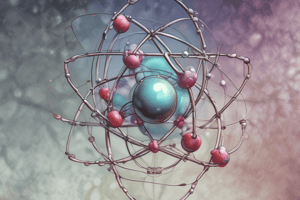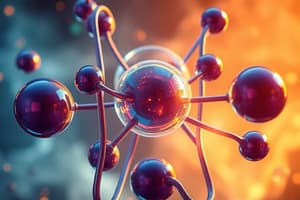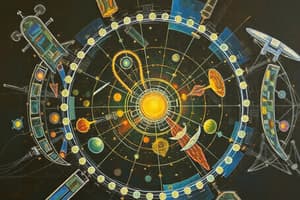Podcast
Questions and Answers
How many of the properties listed by Janie were chemical and how many were physical?
How many of the properties listed by Janie were chemical and how many were physical?
- 4 chemical, 0 physical
- 3 chemical, 1 physical
- 1 chemical, 3 physical
- 2 chemical, 2 physical (correct)
Which property listed by Mae appears to be incorrect?
Which property listed by Mae appears to be incorrect?
- IV
- II (correct)
- III
- I
Based on the given chart, which element corresponds to atomic number 13?
Based on the given chart, which element corresponds to atomic number 13?
- arsenic
- antimony
- aluminum (correct)
- argon
How are elements organized on the periodic table?
How are elements organized on the periodic table?
What is the correct name of the ionic compound formed from magnesium and fluorine?
What is the correct name of the ionic compound formed from magnesium and fluorine?
What primarily differs copper(I) oxide from copper(II) oxide?
What primarily differs copper(I) oxide from copper(II) oxide?
What is the chemical formula for calcium chloride?
What is the chemical formula for calcium chloride?
What is the chemical formula for nitrogen trioxide?
What is the chemical formula for nitrogen trioxide?
What happens to the mass of products after adding 10 g of Alka-seltzer to 210 g of water in a sealed container?
What happens to the mass of products after adding 10 g of Alka-seltzer to 210 g of water in a sealed container?
Which statement is true regarding helium, neon, and argon?
Which statement is true regarding helium, neon, and argon?
Which row identifies the elements and number of atoms in one molecule of C6H12O6?
Which row identifies the elements and number of atoms in one molecule of C6H12O6?
Which type of compound forms when sodium and chlorine react together?
Which type of compound forms when sodium and chlorine react together?
What physical property is demonstrated by copper?
What physical property is demonstrated by copper?
Which student most likely produced a new chemical substance?
Which student most likely produced a new chemical substance?
Which pairs of elements have the most properties in common?
Which pairs of elements have the most properties in common?
What type of element is likely to form an ionic compound when combined?
What type of element is likely to form an ionic compound when combined?
Which of the following substances is classified as a solution?
Which of the following substances is classified as a solution?
How many electrons are in one beryllium atom?
How many electrons are in one beryllium atom?
Flashcards
What are chemical and physical properties?
What are chemical and physical properties?
A chemical property describes how a substance reacts with other substances. A physical property describes aspects of a substance that can be observed without changing its chemical composition.
How many properties of substance X are chemical and how many are physical?
How many properties of substance X are chemical and how many are physical?
The reaction of a substance with acid to produce bubbles indicates the release of a gas, which is a chemical change. The reaction with oxygen, melting point, and solubility in water are all physical properties.
What are Atomic Mass and Atomic Number?
What are Atomic Mass and Atomic Number?
Atomic mass refers to the total number of protons and neutrons in an atom's nucleus. The atomic number represents the number of protons in the nucleus.
How are elements organized on the periodic table?
How are elements organized on the periodic table?
Signup and view all the flashcards
How does an atom become a positive ion?
How does an atom become a positive ion?
Signup and view all the flashcards
What is the name of the ionic compound formed when Magnesium combines with Fluorine?
What is the name of the ionic compound formed when Magnesium combines with Fluorine?
Signup and view all the flashcards
What is the difference between copper (I) and copper (II)?
What is the difference between copper (I) and copper (II)?
Signup and view all the flashcards
What is a chemical equation?
What is a chemical equation?
Signup and view all the flashcards
Exothermic Reactions
Exothermic Reactions
Signup and view all the flashcards
Endothermic Reactions
Endothermic Reactions
Signup and view all the flashcards
Law of Conservation of Mass
Law of Conservation of Mass
Signup and view all the flashcards
Alkali Metals
Alkali Metals
Signup and view all the flashcards
Halogens
Halogens
Signup and view all the flashcards
Noble Gases
Noble Gases
Signup and view all the flashcards
Solution
Solution
Signup and view all the flashcards
Ionic Compound
Ionic Compound
Signup and view all the flashcards
Molecular Compound
Molecular Compound
Signup and view all the flashcards
Chemical Property
Chemical Property
Signup and view all the flashcards
Study Notes
Question 1 - Substance Properties
- Four properties of substance X were listed.
- Two of the properties are chemical and two are physical.
- Chemical properties involve a change in the substance's composition:
- Reacts with acid to form bubbles.
- Reacts with oxygen.
- Physical properties describe the substance without changing its composition:
- Not soluble in water.
- Melting point of 100°C.
Question 2 - Atomic Particle Properties
- Mae's list of atomic particle properties had one error
- The question does not give the list of properties.
- Option to answer the question is provided.
Question 3 - Element Identification
- The element has atomic number 13 and atomic mass 27.0.
- The element that fits this description is aluminum (Al).
Question 4 - Periodic Table Organization
- Elements on the periodic table are arranged vertically in groups (also known as families).
Question 5 - Chemical Formula Representation
- The correct simplified diagram for AlCl₃ (aluminum chloride) is not provided.
- Answer options (I, II, III, or IV) are necessary for determining which is correct.
Question 6 - Ion Formation
- To become a positive ion, an atom must lose electrons.
Question 7 - Ionic Compound Naming
- The correct name for the ionic compound formed by magnesium and fluorine is magnesium fluoride.
Question 8 - Difference between Copper(I) and Copper(II) Oxide
- The main difference between copper(I) oxide and copper(II) oxide is the charge of the copper ion.
Question 9 - Calcium Chloride Chemical Formula
- The chemical formula for calcium chloride is CaCl₂.
Question 10 - Nitrogen Trioxide Chemical Formula
- The chemical formula for nitrogen trioxide is NO₃.
Question 11 - Reaction Equation
- The balanced equation that describes the reaction is CaCO₃ + 2HCl → CaCl₂ + H₂O + CO₂.
Question 12 - Factors Affecting Reaction Rate
- Factors that affect the rate of a reaction include temperature, concentration, and surface area of the reactants.
Question 13 - Chemical Reaction Description
- Chemical reactions involve the rearrangement of atoms, typically by gaining, losing, or sharing electrons.
Question 14 - Mass Conservation in Reactions
- In a chemical reaction, mass is conserved, meaning the mass of reactants equals the mass of products.
Question 15 - Exothermic/Endothermic Reactions in Egg Frying
- The egg frying and the fire burning are both exothermic reactions.
Question 16 - Element Conductivity
- The question doesn't provide specific element identifications.
- Options are required for answering conductivity of elements III and IV
Question 17 - Properties of Helium, Neon, and Argon
- Helium, neon, and argon are inert gases (noble gases) and have different numbers of protons, electrons, and neutrons.
Question 18 - Atoms in a Glucose Molecule
- One molecule of glucose (C₆H₁₂O₆) contains 6 carbon atoms, 12 hydrogen atoms, and 6 oxygen atoms.
Question 19 - Element Type and Compound Formation
- Non-metallic elements typically form molecular compounds when combined.
Question 20 - Classification of a Substance as a Solution
- Acid rain is an example of a solution.
Question 21 - Chemical Formula Determination
- Without the molecule, the chemical formula cannot be determined.
- Answer options (P₂H₅OH, P₂H₅CH, C₂H₅OH, O₂H₅CH) might be the options for answering the question.
Question 22 - Number of Electrons in Beryllium
- A beryllium atom has 2 electrons.
Question 23 - New Chemical Substance Production
- The question does not provide information from the relevant experiment.
- Answering options (Student 1, Student 2, Student 3, Student 4) and the experiments will help determine which student produced a new chemical substance.
Question 24 - Elements with Similar Properties
- Fluorine and chlorine (both halogens) have the most properties (chemical and physical) in common.
Question 25 - Sodium Chloride Compound Properties
- Sodium and chlorine form an ionic compound called sodium chloride.
- When dissolved in water, the ionic compound dissociates into ions, allowing it to conduct electricity.
Question 26 - Physical Property Description
- Copper conducting electricity is a physical property.
Numerical Response 1 - Element Groupings
- Matches elements with the correct group names.
Numerical Response 2 - Chemical vs. Physical Changes
- Classifies given examples into chemical or physical changes.
Numerical Response 3 - Metal or Non-metal Classification
- Classifies elements as either metals or non-metals.
Studying That Suits You
Use AI to generate personalized quizzes and flashcards to suit your learning preferences.




